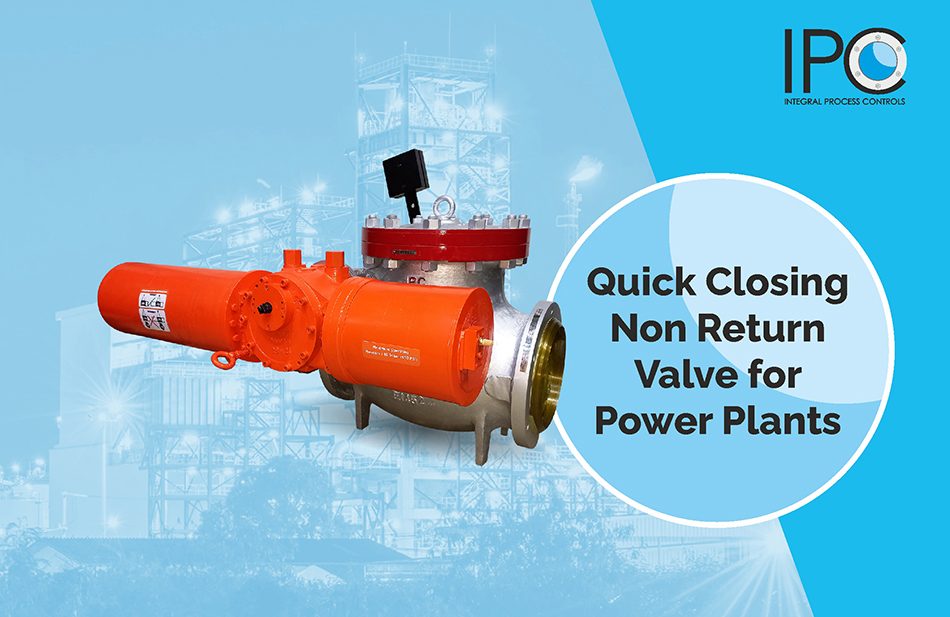Handling steam in power stations is a bit tricky. Steam plays an important role in generating electricity, but it’s critical and difficult to handle, reverse flow of steam can be dangerous and can impact safety of the crucial equipment in a big way. A critical component in achieving this is the Quick Closing Non Return Valve (QCNRV), particularly in turbine extraction pipelines.
Understanding the Significance
Quick Closing Non Return Valves, often referred to as Swing Check Valves, play a pivotal role in the power generation process, particularly in handling steam. Their primary function is to prevent reverse flow, ensuring that steam flows only in one direction. This simple yet crucial mechanism serves to protect turbines from potential damages caused by backflow.
Safeguarding Turbines: A Necessity
In the context of captive power plants, where turbines are the heart of operations, the need for uninterrupted and safe functioning is non-negotiable. These powerhouses are responsible for converting steam energy into mechanical energy, which is then converted into electrical energy. Any disruption in this process can lead to downtime, loss of productivity and more critically, expensive damages to key equipment.
This blog delves into the operational insights, benefits and sophisticated mechanisms of these valves. This is ensure a seamless, safe and efficient power generation process.
Key Benefits of Quick Closing Non Return Valves (QCNRV)
Rapid Closure:
These valves are capable of closing in less than a second, a crucial feature in preventing the backflow of steam and ensuring the system’s safety.
Complete Disc Closure:
At no flow condition, the valve achieves a complete disc closure, ensuring a tight shut-off and preventing leakage.
Reliable Reverse Flow Prevention:
The primary function of a QCNRV is to prevent the reverse flow of steam, safeguarding the turbine and other critical components from damage.
Innovative Actuation:
Equipped with a side-mounted pneumatic spring return actuator. These valves offer a reliable and efficient operation, enhancing their functionality in emergency conditions.
How do Quick Closing Non Return Valves (QCNRV) Operate
QCNRVs are specially designed swing-disk check valves, integral to the turbine steam bleeding lines of the feedwater preheating stages in modern power station cycles. Their main function is to quickly shut off the bleeding steam pipes in case of a loss of turbine load. This action is crucial in preventing the dangerous phenomenon of water carryover from the preheater back to the turbine, which can cause significant damage and efficiency losses.
The innovative design includes a pneumatic single-acting actuator (Spring Return) mounted on one side of the valve body, linked to the valve disk through a shaft. This setup ensures that the valve can operate automatically in a conventional manner under normal conditions with the actuator air pressure ranging between 4 and 8 bar.
During manual operation, compressed air is fed into the cylinder, loading the spring and allowing the check valve to operate automatically. In emergencies or during turbine upset conditions, the compressed air is vented. This action allows the spring to extend inside the cylinder, causing the actuator piston to rotate the valve disk and intercept the steam-bleeding pipe swiftly. The spring’s main function is to overcome the starting friction on the packing and pivot bearings, ensuring a quick and reliable closure.
Ensuring Operational Excellence
When it comes to power plants operations , where every minute of downtime translates to revenue loss, the importance of proactive measures cannot be overstated. Quick Closing Non Return Valves stand as silent guardians, constantly monitoring and regulating steam flow to safeguard turbine operations.
By integrating IPC Make QCNRV valves into power stations, facilities can achieve a higher level of control over steam flow. This is significantly reducing the risk of damage from reverse flow and water carryover. The rapid actuation, reliable reverse flow prevention and tight shut-off capabilities make these valves an indispensable part of modern power generation infrastructure, ensuring the seamless operation and longevity of turbine systems.

